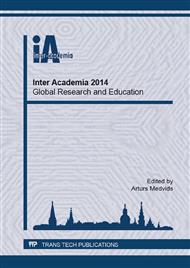p.118
p.122
p.126
p.132
p.139
p.143
p.147
p.152
p.156
Synthesis and Characterization of Nb-Doped TiO2 Thin Films Prepared by RF Magnetron Sputtering
Abstract:
Amorphous Nb-doped TiO2 thin films were deposited on (100) Si and glass substrates at room temperature by RF magnetron sputtering and a mosaic-type Nb2O5-TiO2 sputtering target. To adjust the amount of the niobium dopant in the film samples, appropriate numbers of Nb2O5 pellets were placed on the circular area of the magnetron target with intensive sputtering. By adjusting the discharge conditions and the number of niobium oxide pellets, films with dopant content varying between 0 and 16.2 at.% were prepared, as demonstrated by X-ray photoelectron spectroscopy data. The X-ray diffraction patterns of the as-deposited samples showed the lack of crystalline ordering in the samples. Surfaces roughness and energy band gap values increase with dopant concentration, as showed by atomic force microscopy and UV-Vis spectroscopy measurements.
Info:
Periodical:
Pages:
139-142
Citation:
Online since:
July 2015
Keywords:
Price:
Сopyright:
© 2015 Trans Tech Publications Ltd. All Rights Reserved
Share:
Citation:


